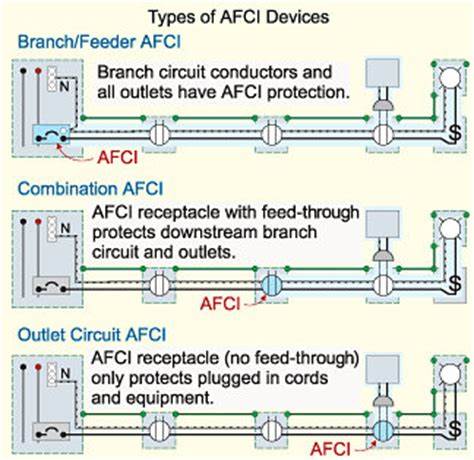Arc Fault Circuit Interrupters (AFCI)
Are AFCI breakers really necessary?
AFCIs have proven so effective at preventing electrical fires that the National Electrical Code (NEC) requires AFCIs to be installed in almost every room in newly built houses or in new circuits during remodels. Bathrooms, garages, and unfinished basements—areas defined as non-living spaces—are among the few exceptions.
What does an AFCI breaker do?
The AFCI circuit breaker serves a dual purpose – not only will it shut off electricity in the event of an “arcing fault”, but it will also trip when a short circuit or an overload occurs.
What is the difference between AFCI and GFCI breakers?
GFCI and AFCI outlets are two important safety features that can help protect your home from electrical fires. GFCI outlets trip when they sense a short to ground, while AFCI outlets trip when they detect an arc fault.
If installed incorrectly, an AFCI device can cause a lot of problems. The breaker or receptacle AFCI may not protect your home from fire and can lead to a false sense of security. Improperly installed AFCI devices can also lead to nuisance tripping of the circuit. Some cheap appliances and cheap box store lighting have been known to cause nuisance trips as well.
Should I replace breakers with AFCI?
The 2008 National Electrical Code (NEC) requires AFCI breakers in nearly all new construction. In 2017, the requirement was updated to require AFCI protection in virtually every room in a home. According to the NEC, AFCI protection is necessary for 15- and 20-ampere branch and 120-volt, single-phase circuits for devices and outlets. Older and historic homes may not require these breakers, but experts still recommend them. Newer homes should have AFCIs in compliance with NEC guidelines.
Where should AFCI breakers be installed?
In addition to those areas where AFCIs are required by NEC standards, you will want to install them for every outlet and device, if possible. Any larger device can overheat, and rodents can chew through any wiring in your home or business, whether your property is newer or older. AFCIs are simple and effective ways to offer added protection against the property damage and personal loss a fire can cause.
AFCIs have proven so effective at preventing electrical fires that the National Electrical Code (NEC) requires AFCIs to be installed in almost every room in newly built houses or in new circuits during remodels. Bathrooms, garages, and unfinished basements—areas defined as non-living spaces—are among the few exceptions.
What does an AFCI breaker do?
The AFCI circuit breaker serves a dual purpose – not only will it shut off electricity in the event of an “arcing fault”, but it will also trip when a short circuit or an overload occurs.
What is the difference between AFCI and GFCI breakers?
GFCI and AFCI outlets are two important safety features that can help protect your home from electrical fires. GFCI outlets trip when they sense a short to ground, while AFCI outlets trip when they detect an arc fault.
If installed incorrectly, an AFCI device can cause a lot of problems. The breaker or receptacle AFCI may not protect your home from fire and can lead to a false sense of security. Improperly installed AFCI devices can also lead to nuisance tripping of the circuit. Some cheap appliances and cheap box store lighting have been known to cause nuisance trips as well.
Should I replace breakers with AFCI?
The 2008 National Electrical Code (NEC) requires AFCI breakers in nearly all new construction. In 2017, the requirement was updated to require AFCI protection in virtually every room in a home. According to the NEC, AFCI protection is necessary for 15- and 20-ampere branch and 120-volt, single-phase circuits for devices and outlets. Older and historic homes may not require these breakers, but experts still recommend them. Newer homes should have AFCIs in compliance with NEC guidelines.
Where should AFCI breakers be installed?
In addition to those areas where AFCIs are required by NEC standards, you will want to install them for every outlet and device, if possible. Any larger device can overheat, and rodents can chew through any wiring in your home or business, whether your property is newer or older. AFCIs are simple and effective ways to offer added protection against the property damage and personal loss a fire can cause.

This is not an all inclusive list of every issue that can be present with a safe electrical circuit, but gives you a good understanding of AFCI devices.
